A moment of nostalgia: prices for computers and accessories from 2002
Carrying out New Year's cleaning, I found an old price list from the year 2002 from the Tsaritsyno radio market (Moscow). Yes, at that wildest time, price lists were still printed on paper. Spread it on public display. Those who remember this time will rejoice, and those who did not find it will see which components were then sold and how much. According to the then tradition, prices are indicated in U.E. and in rubles.
Front side (1920х2636);
Back side (1920х2636).
I don’t know if this company exists now. For a long time I have not been to the Tsaritsyno market. The company was quite large, it occupied a large pavilion in the center of the market and another smaller pavilion on the periphery. Eyes were scattered when the child looked at the shelves, cluttered with various components, cases and other junk. The company page indicated at the bottom of the price list no longer opens, and only in the bowels of the Internet Wayback Machine can you find old copies of this site.
This artifact is printed in very small print in four columns on both sides of the A4 sheet with a laser printer, and then copied on a copy machine. To read such a text, the average person needs a threefold magnifier. Let's go in order.
To begin with, we will pay attention to the reference system adopted in this document.

The first in order is a huge section on motherboards. Many manufacturers from that price list are no longer alive. In the assortment of the company were: Soltek, Epox, DFI, Acorp, Asustek, Chaintech, Abit, MSI, Gigabyte, Intel and Tomato. It was the time of the i815, i845, i850, AMD761, VIA KT266, VIA KT333, SiS645 chipsets for Pentium 4 and AMD Athlon and Duron, and the memory - DIMM, the first DDR and Rambus. The era of AT computers has already passed. The era of combined motherboards that could be installed in both AT and ATX chassis is ending. Slot processors have already become unfashionable. The ISA bus has already disappeared, but not completely. The boards have built-in sound and USB, but no LAN. Most of these boards carry the proud sticker “Made in Taiwan”, some “Made in Singapore”, but quite a lot are already made in China.
The price list was compiled not in alphabetical order, but in the order of “steepness” of firms, as it was then thought. Starting with the most unpretentious and ending with the most "ponto".
Column dedicated to Soltek boards:

As you can see, this company made a large number of mid-range boards for almost all the processors of the time. Its boards are not distinguished by anything special, there are no special “chips”, the price is lower than asus and intel, but higher than acorp and tomato. Prices from 1775 r for the cheapest payment to 3651 r for the most sophisticated. By the way, pay attention to a typical board configuration.
Epox Board Column:
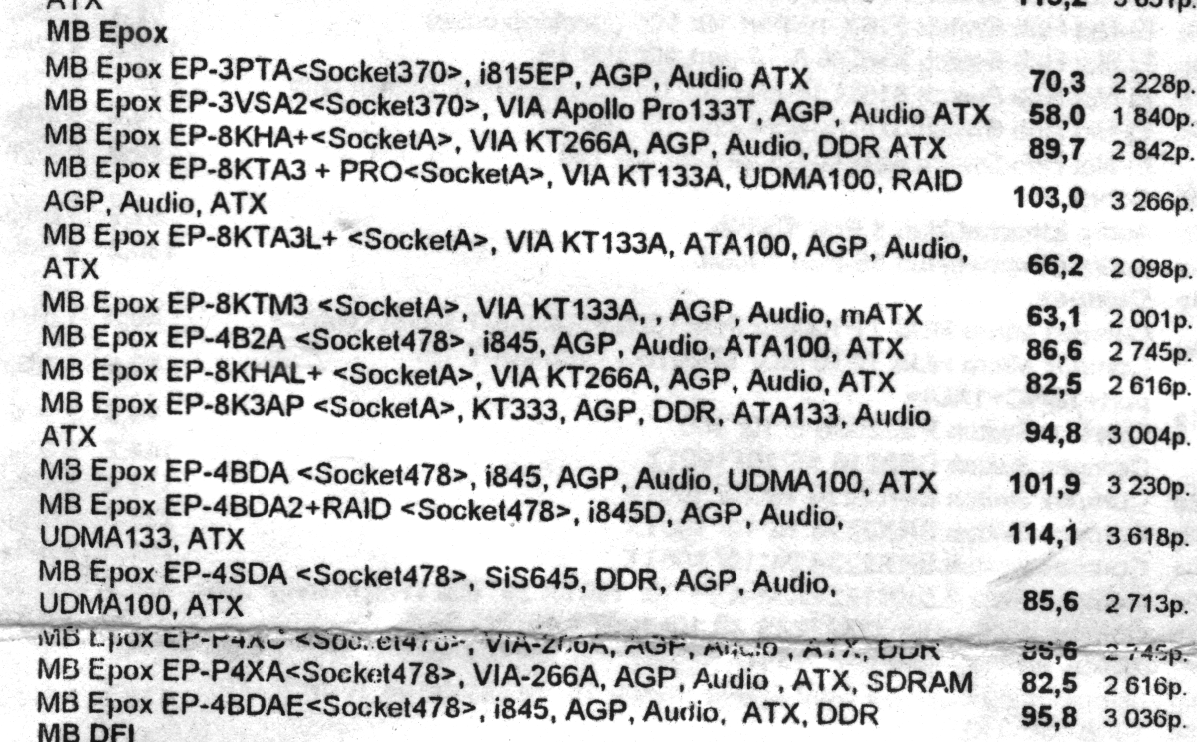
I absolutely do not remember this company. I did not have a chance to encounter her boards. Prices are in the same range as the previous player, from 1840 p to 3618 p. One board with a Raid controller is allocated. In those days, when the board had typically two slots for the parallel interface of the hard drive, in total 4 of them could be connected, and there were no built-in RAID controllers on the boards. Those interested could buy a separate board with RAID, and it was expensive.
DFI Board Column:

Boards and this company passed me by. It is also a mid-range manufacturer, rather, mid-low. Prices from 1872 p. up to 3521 p. However, it is clear that these comrades love to experiment. Pay attention to the large number of motherboards with SiS chipsets for the fourth days. I remember that these chipsets did not differ in reliability and stability. Rather, they differed, but only among the most direct-handed. Here, for the first time on this list, we come across a board under RIMM - Rambus memory. There is also a group of office stripped-down boards with integrated video for mATX.
Acorp motherboards:
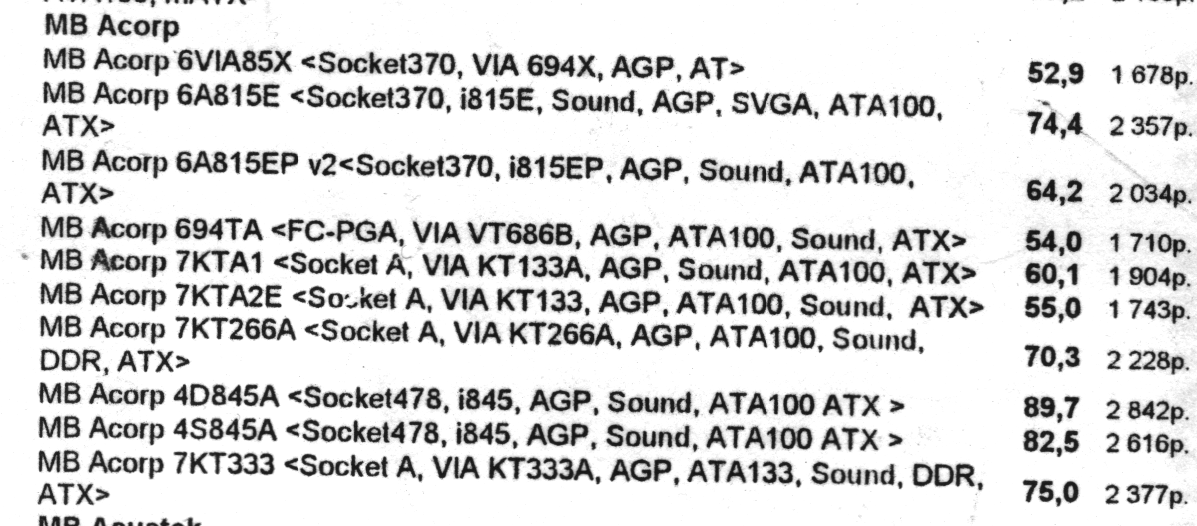
Acorp then produced a lot of junk, from motherboards to modems. Typical manufacturer of the lower echelon, the lowest prices from 1618 p to 2842 p. In this price list, he holds second place for the cheapest and most outdated board (after Tomato). Take a look, the first on the list is the Acorp 6via85X on Socket 370 for Celerons and PIII, with DIMM memory, ISA bus and AT! This is the same combination board that could work with both the AT power supply and the ATX power supply. The connecting dimensions she had under AT. At one time, it was a good option for upgrading old computers.
Asus motherboards:
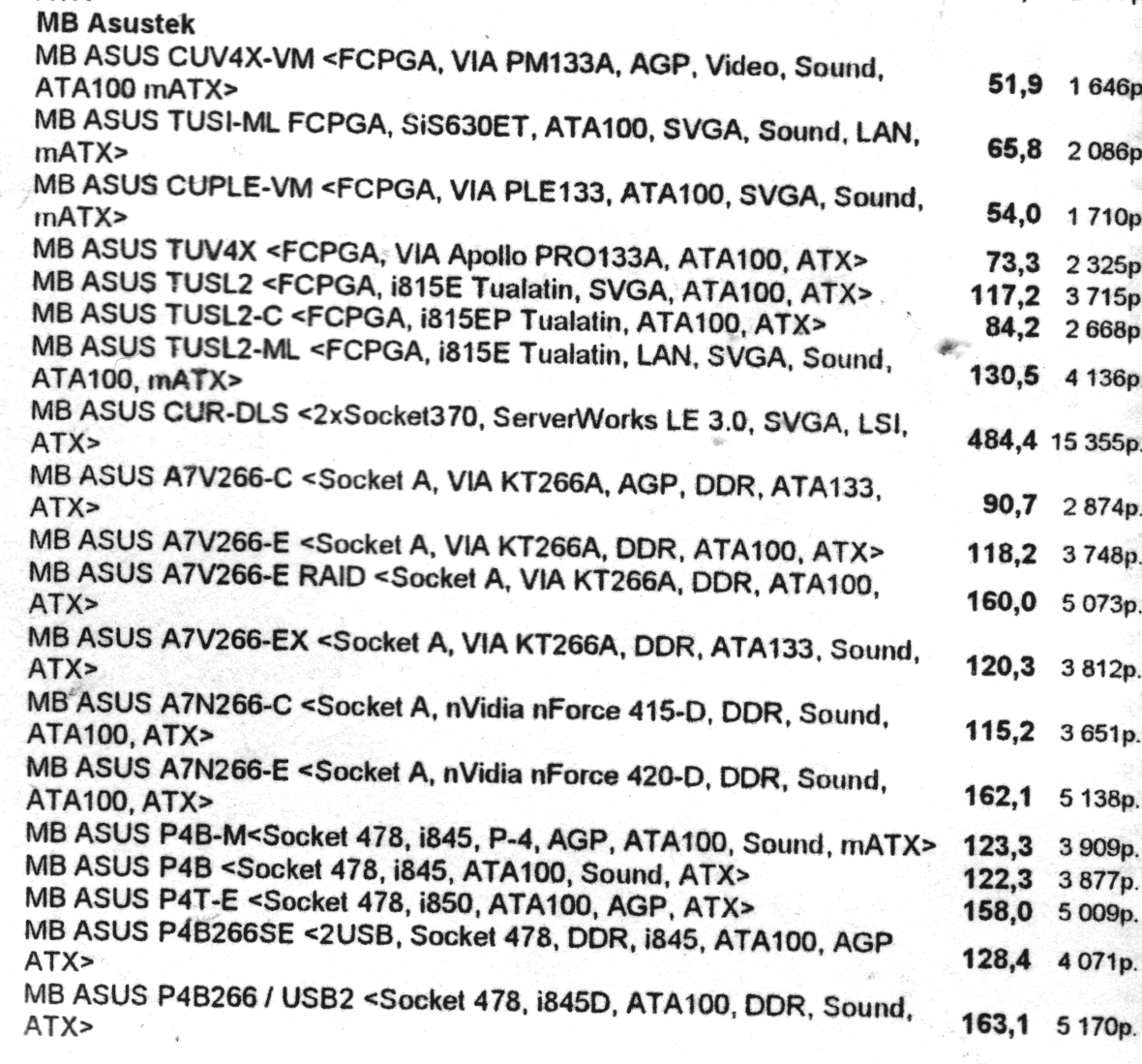

They had a lot of boards in that price list. And cheap office, and expensive gaming, and even one dual-processor board. Asus CUR-DLS is designed for two Socket370. I have no idea who and why such a configuration in the Pentium era 4 could be needed, which alone could replace this bunch. Apparently, someone ordered this board a couple of years ago and did not buy it. Noteworthy is the variety of chipsets, and Intel, and AMD, and VIA, and even SiS and nVidia (nForce 415, nForce 420). The brand was then popular, in great demand.
Chaintech motherboards:

A similar mid-range firm, held closer to the middle.
Abit motherboards:

The list is entirely "tricked out" expensive boards, with prices from 1969 p to 5752 p. A very interesting “gift set” from a gaming motherboard and keyboard with an Abit Max IT7 mouse. No one had this, and did not even meet later.
MSI motherboards:
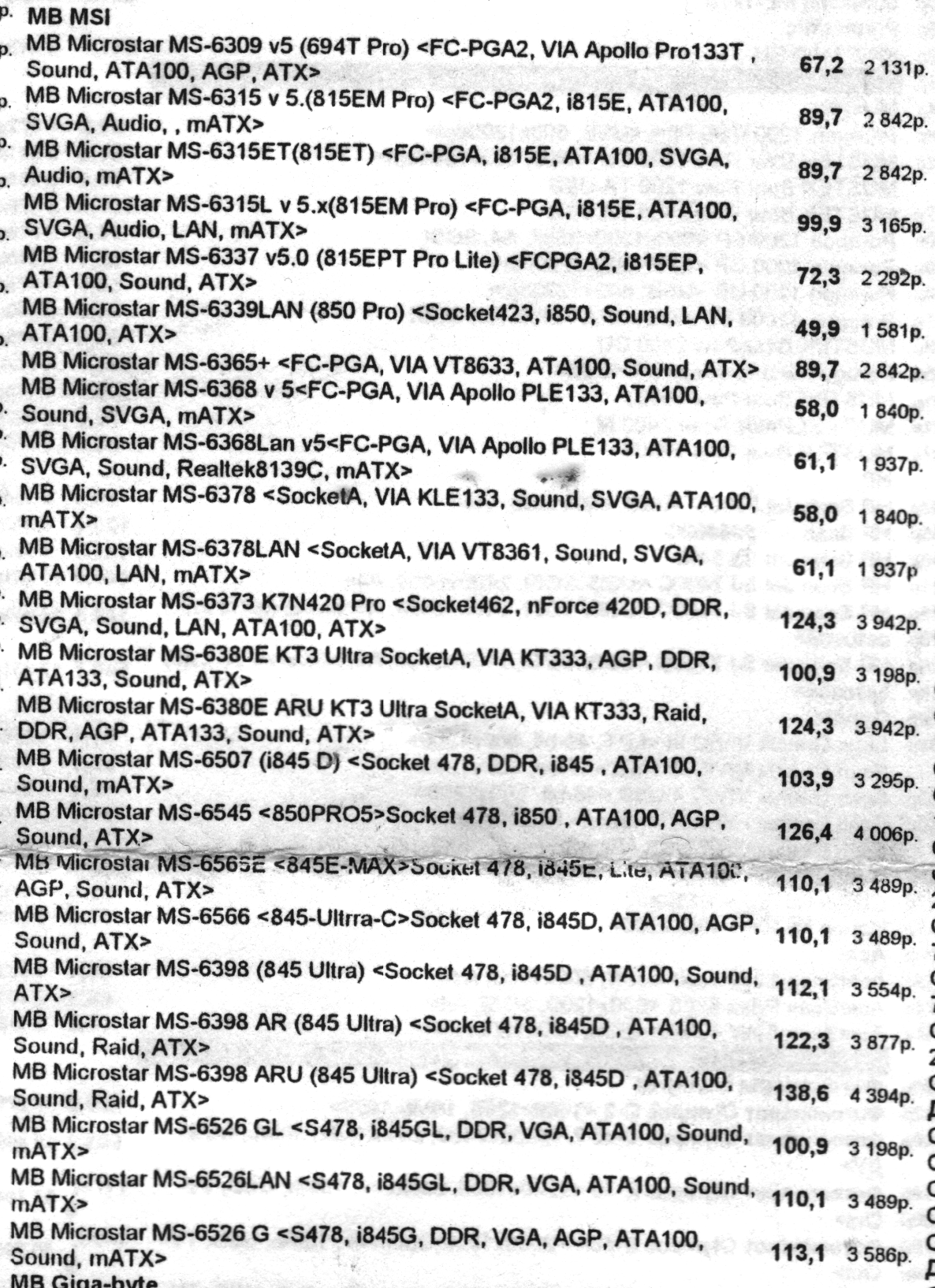
MSI has survived to this day with an expanding assortment. In the price there are several cheap office scarves for mATX with built-in video, and expensive gaming with all that is possible. Prices from 1840 p to 4394 p.
Gigabyte motherboards:

And this company has survived to this day. Several office and mid-range gaming boards with prices ranging from 1,743 r to 3,230 r.
Intel motherboards:
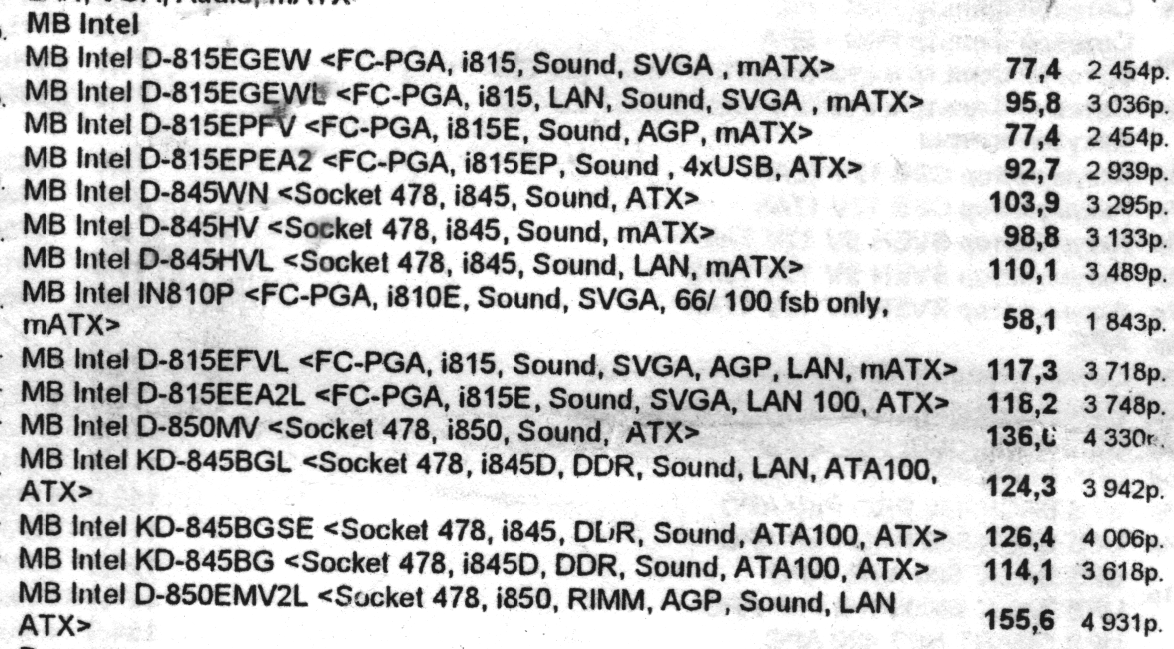
Judging by their location at the end of the list and the price set, these boards were considered the “coolest” in this company. In appearance, nothing special, but the prices are up to 4931 r.
Finally, the “Miscellaneous” section:

This section contains the motherboard for Socket 7 (the first Pentium), which is not known to be lying around in their warehouse.
The next section is about processors. And it starts with the “Miscellaneous” section, which presents the VIA C3 family of processors for Socket 370.

These processors were produced for a short time, and were not particularly popular. The advantage was only their low heat dissipation and low cost. Their descendants are now working in all kinds of embedded systems in the Mini-ITX and Nano-ITX formats.
AMD Athlon processors:

AMD Duron processors:


The AMD processors popular at that time under Socket A. Durons after some time left a scene. Pay attention to the marking of the processors of that time. They indicated the clock frequency, not abstract indexes. However, for AMD processors, the clock speed did not match the designations. The clock speed of the Pentium 4 processor comparable to that of the processor (and for durons - Celeron) was written on their cases. The actual clock speed was slightly lower.
Celeron processors:

Almost everything under Socket 370 (truncated PIII), and one under 478 (truncated P4).
Pentium 3 processors:

Pentium 3 is still in the price list, but only a few items. There are still motherboards for them, but they are few.
Pentium 4 processors:

Almost everything is under Socket478, one is under 423. According to the location at the end of the list, it is this position that is the “locomotive” of this company.
The position of the "Cooling System" of those times is not much different from today. Heat pipes have already begun to appear, water systems and then massively was not offered. The heat dissipation of those processors was even higher than that of the current ones.

Section "RAM": The


list starts with ordinary flash drives. You see a unique moment: their Russian name has not yet settled down, and they were called Driver! Apparently they wanted to name Drive, but the manager mixed up something. Notice that they started at that time with 16 megabytes, and ended up with 512. And a 512 megabyte flash drive cost 256 gigabytes as it is now! Now do you feel the progress of technology?
The memory cards then were also very small, 128 megabytes was all a pleasure, but the cameras then had few megapixels, so there was something missing.
Section "Hard Drives":

With hard drives they are weak, not all firms that were then on the market are represented. But almost all the top drives are there. 120 gigabyte drive. He had enough for everything. The XP system occupied five gigabytes, films in AVI were placed at 750 megabytes. Now for the cost of 120 GB of that drive, you can buy 2 terabytes.
Section "Zip-drive and magneto-optics" and "Floppy drives":

There are two sections that are now extinct in everyday life, like dinosaurs. They were replaced by flash drives.
Section "Cases":

The cases of those times are not very different from today. The most noticeable difference is the power connectors for SATA drives. And the power has increased slightly. The design is slightly different. Models of that time, and even with the very same power supplies, you can quite afford to buy now and use.
Video Cards Section:


Voodoo 3 and Riva TNT 2 video cards already begin this list. In the middle is the entire color of the time with memory from 16 to 128 megabytes on the GeForce 4 and Radeon 8800 chipsets. And at the end of the list are old Matrox Millenium and cards for video editing Miro Video StudioDV + and Pro One for a crazy amount.
The next section, the most diverse, is Multimedia:
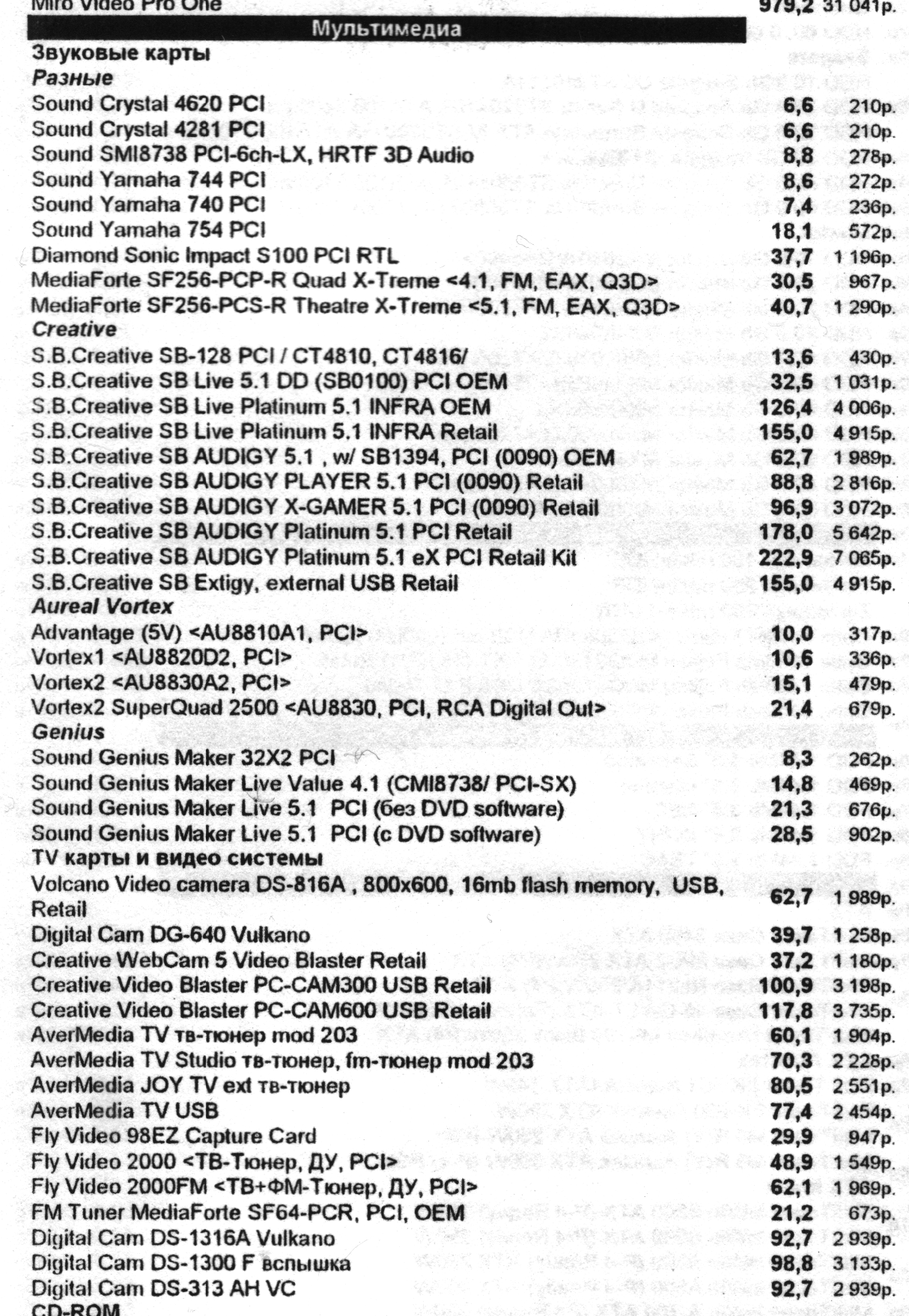
The section begins with built-in sound cards and TV tuners. Now, when television broadcasts can be watched via the Internet, a separate TV tuner is no longer needed, but at that time the Internet was much slower. So there were enough offers from TV tuners. Among them, there was one rootless webcam. Until the era of mass video conferencing and skype a few more years, so few still need webcams.
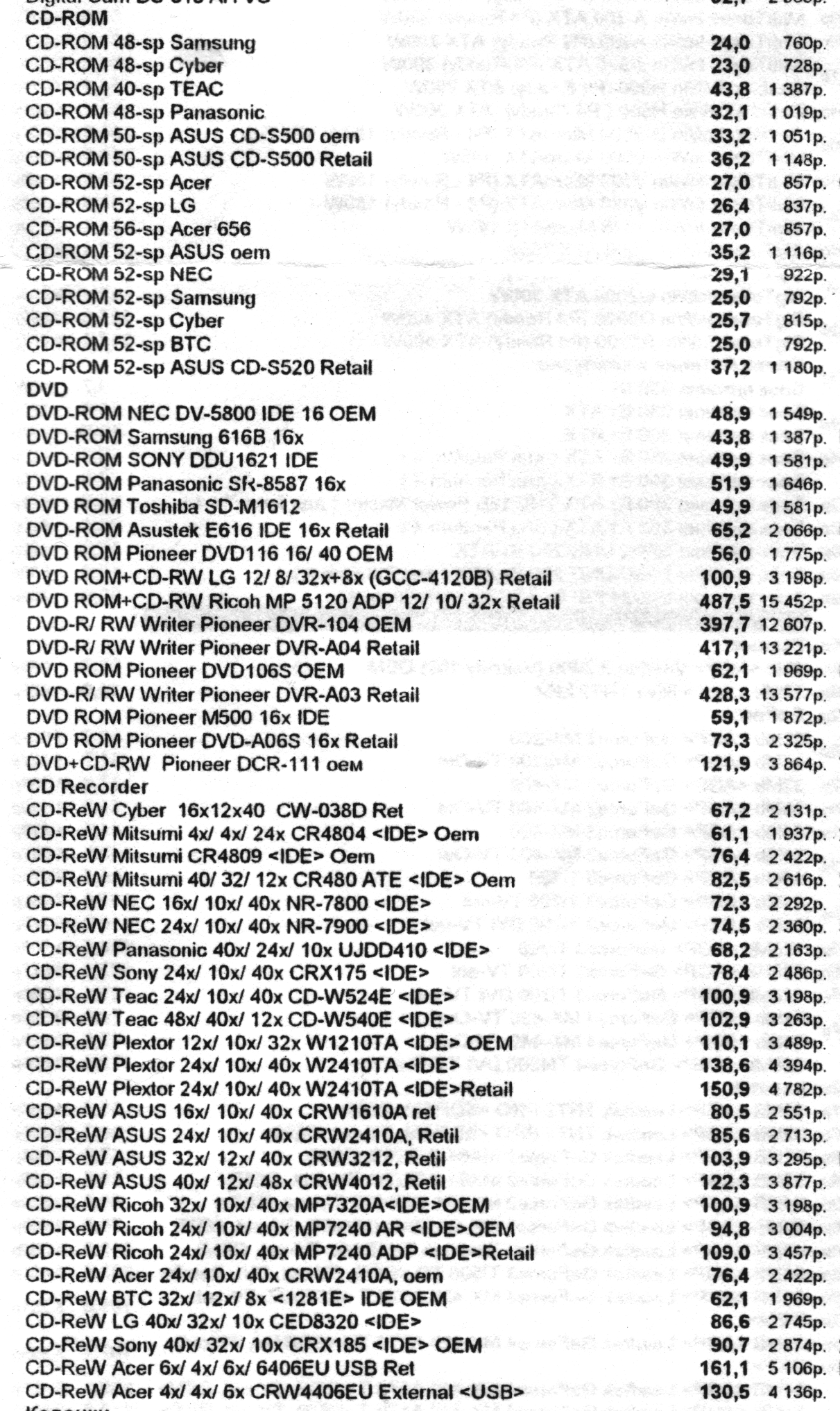
Please note that the price list includes both CD burners and DVD burners at a very high price and low speed, and even drives that read CDs and DVDs, and only write CDs.
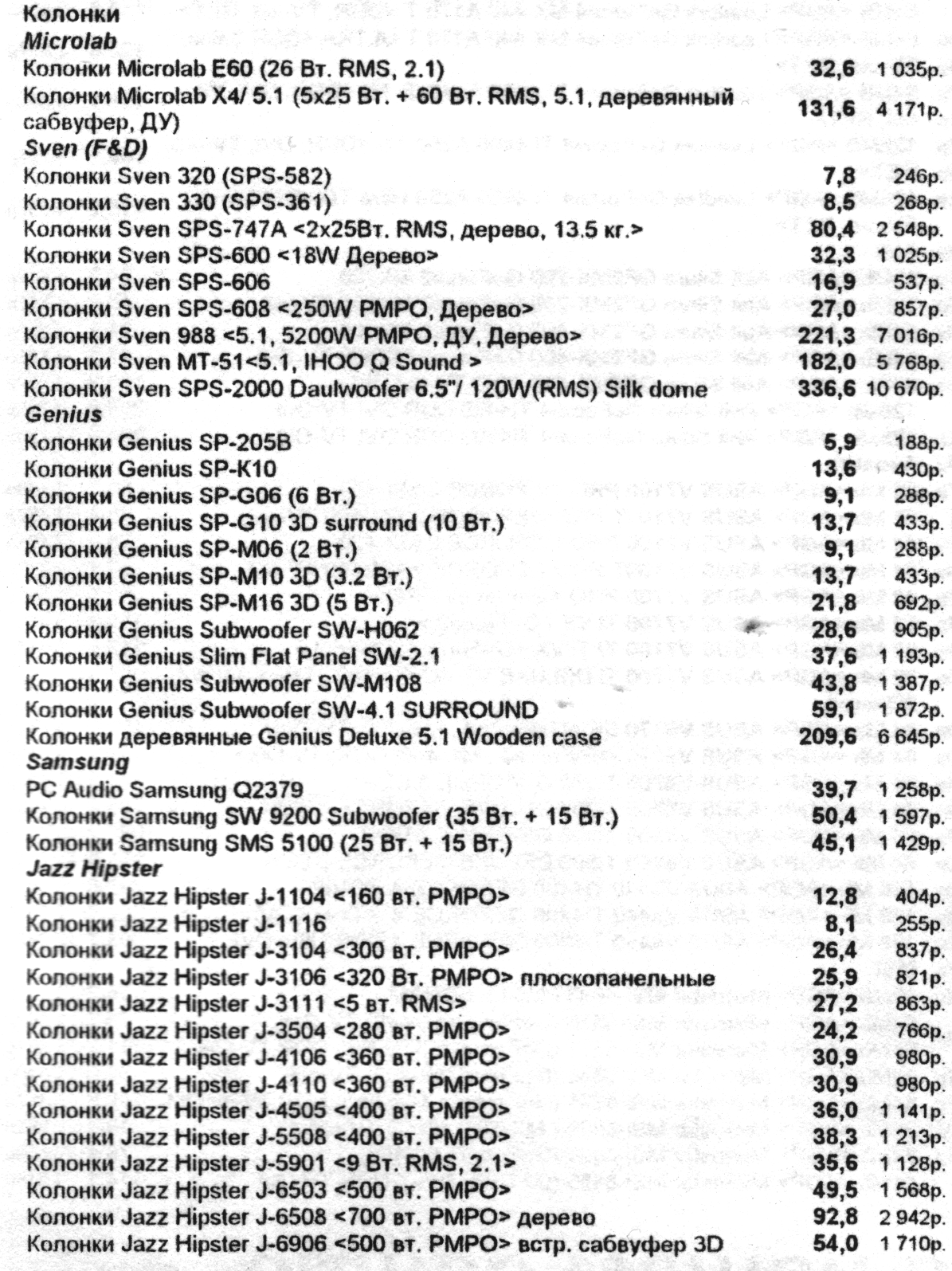
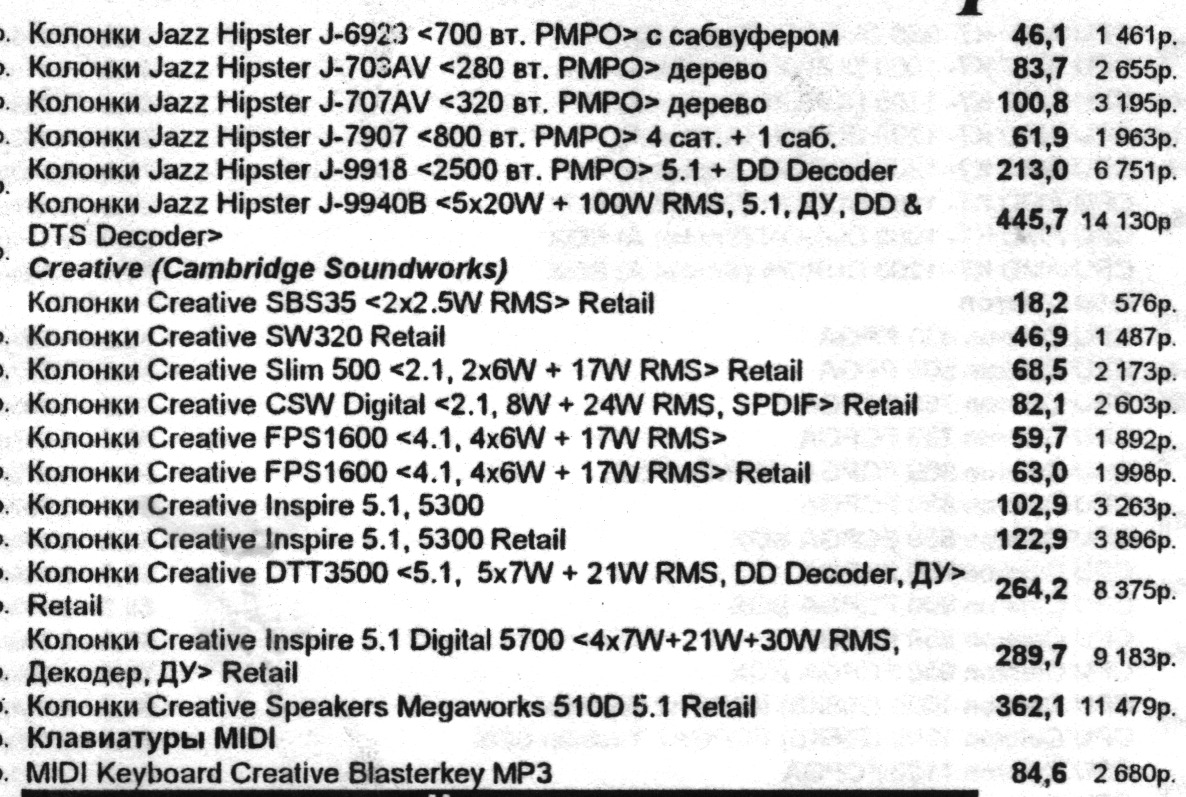
The era of DVD and home theater 4.1 and 5.1 continues. The list includes a bunch of speakers for a home theater, as well as simple speakers 2.0, but there are also “monitor” high-quality 2.0. Progress among speakers is very small, only bluetooth has been added. Please note that the weight of the column is indicated in the list of characteristics of the column - so as not to think that this is a cheap plastic thing, but a real, massive, wooden one.
Section "Monitors". Monitors Samsung:

Monitors LG, Sony, ViewSonic:
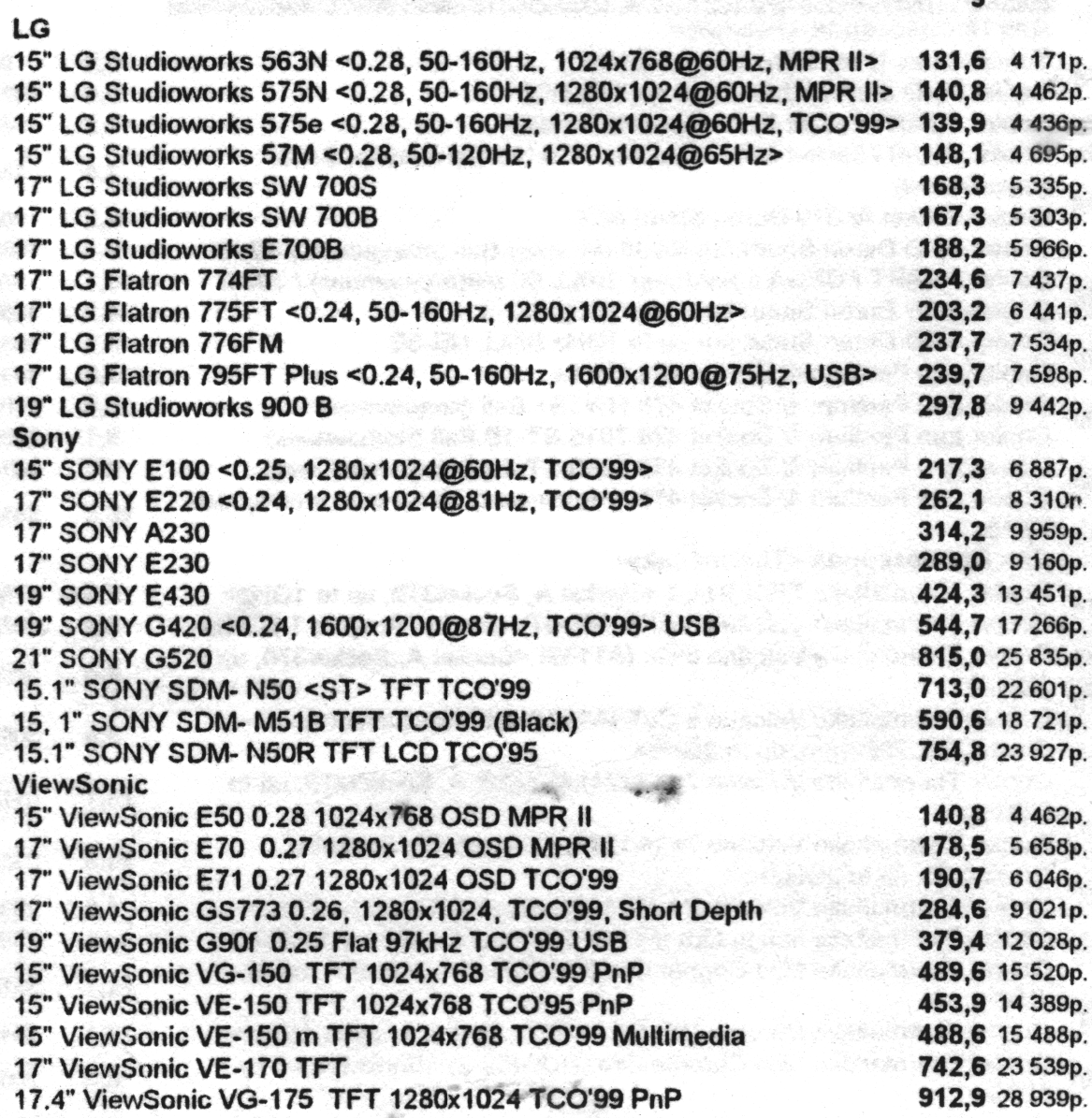
Monitors CTX, Hyundai, Nec, Mitsubishi, Scott:
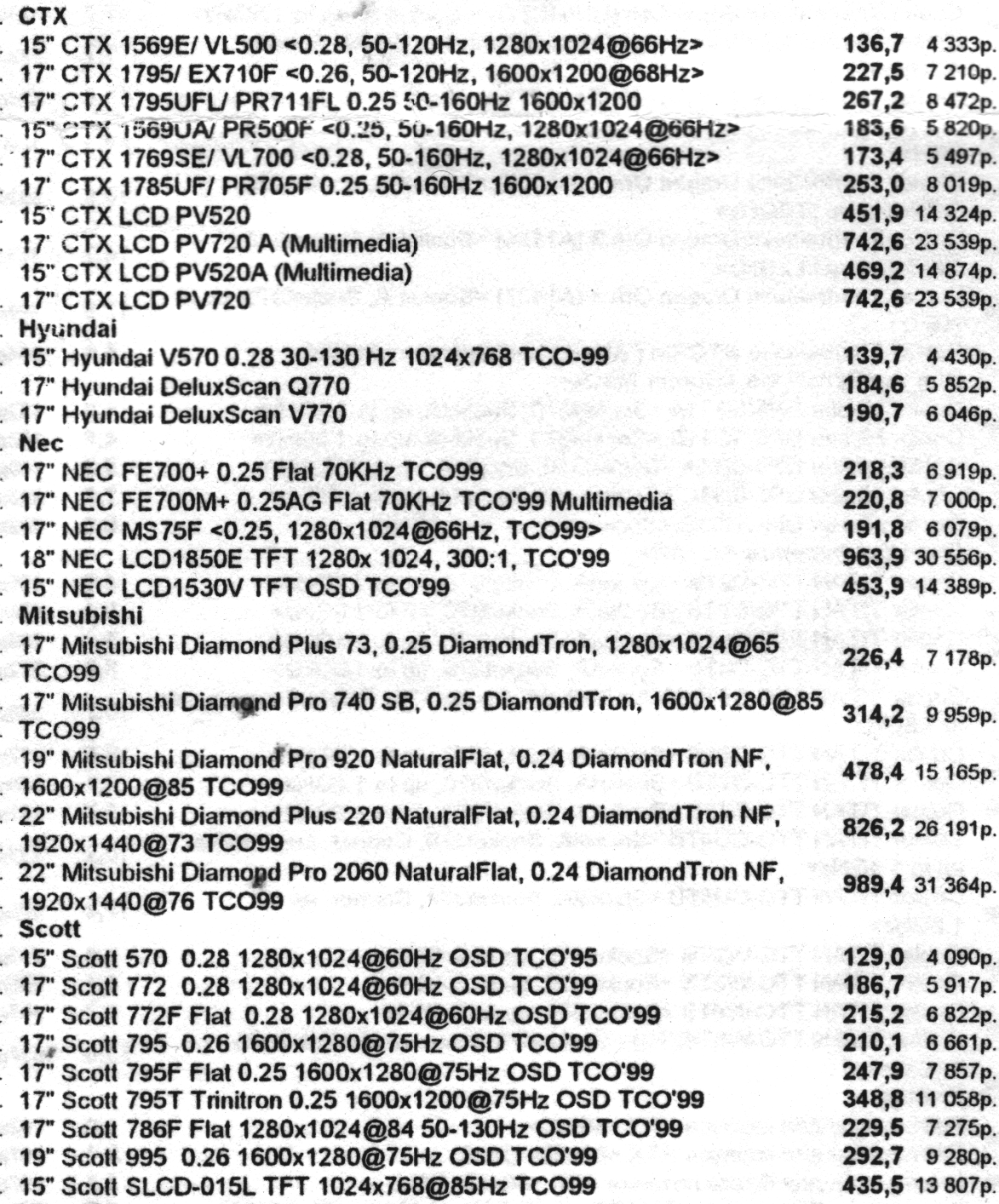
Monitors Hitachi, RoverScan, Fujitsu-Siemens, Acer:

Here, both CRT and LCD monitors are mixed together. The largest monitor on this list is the 22-inch Mitsubishi CRT. The most common 15 and 17 inch. And pay attention to the prices - a fashionable LCD monitor only 17 inches could cost more than a thousand conventional units.
Section “Keyboards” and “Mice and rugs”:

With keyboards, mice and rugs, this company was a little tough. Note that among mice there is only one optical. The remaining two - with a ball! Optical costs three times as much.
Printers

Section : This section begins with Epson Dot Matrix Printers. These are also printers intended not for corporate use in banks, but for home use. But even then they were losing a lot in a jet.

The list goes on with Epson inkjet photo printers and HP printers. Already present, however, at a wild price, are color laser printers. The price of a conventional laser printer is approaching a thousand conventional units. This was a period when companies were just transitioning to the modern business model of "printer at a loss, we get the remainder with consumables." Additionally, there is a pair of A0 inkjet printers. Note that the combined models of "printer-scanner-copier" in the list of only two pieces.
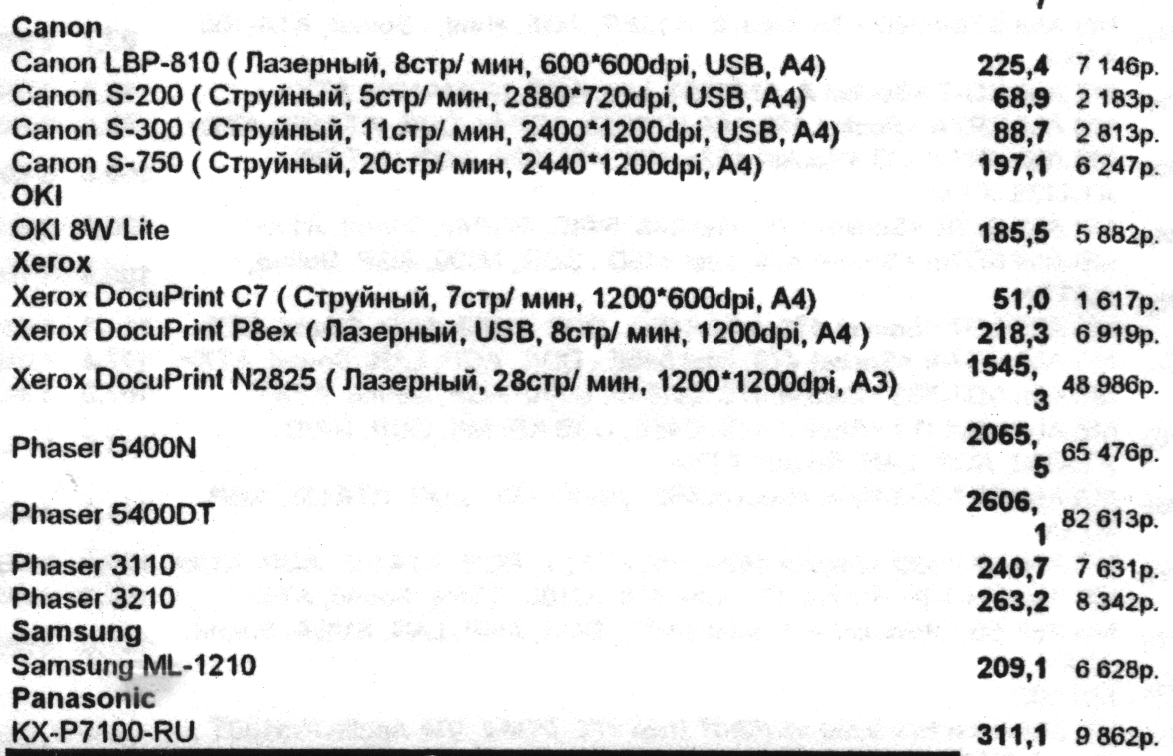
The rest is a couple of models OKI, Xerox, Samsung, Panasonic.
Section "Scanners": There

are a lot of scanners . Now they are not so common, replaced by the combined models mentioned above. SCSI scanners are also sold.
Section "Digital video and cameras":

It can be seen that cameras are not the main activity for this company. So, side. But look at the price of these cameras and their specifications! You get only 5 megapixels for one and a half thousand cu, however, with very good optics. Or a soap dish on 640x480 for almost 100 cu The era of digital photography has been booming. Soon the soap dishes will be replaced by cell phones with built-in cameras and will be sold for $ 20
Section "Uninterruptible Power Supply Units":


And here evolution does not say that it was already very noticeable. Many of these uninterruptible models can be bought now.
Section "Modems":

This section summarizes the actual modems, network cards and hubs. The regular telephone modems begin the section, including the famous USR Courier 56, the FIDO legend. As you can see, the price is level, and this speed is only 56,000. There are no modems for ADSL in the list. ADSL distribution will begin later.
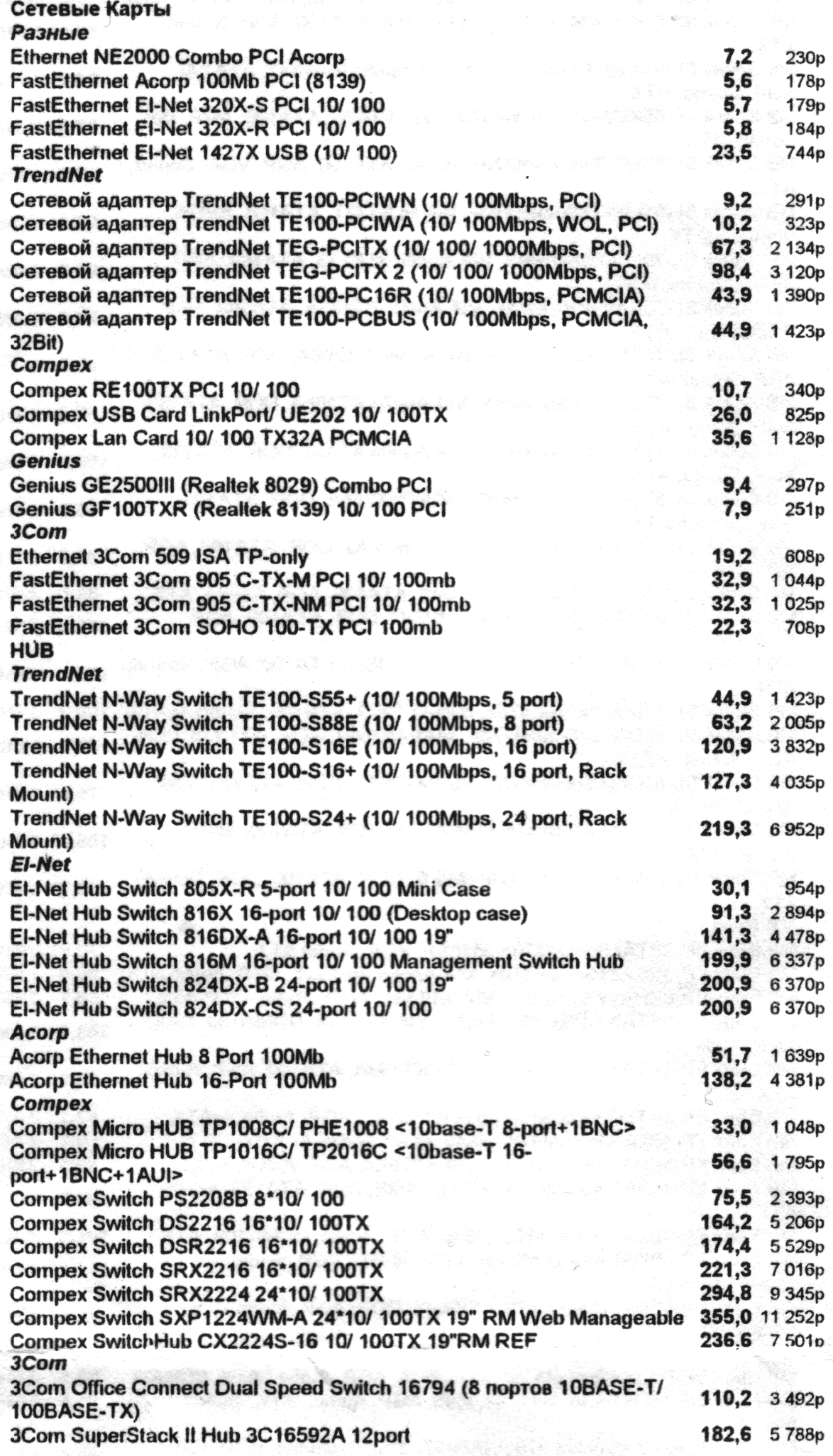
Network equipment is represented by 10/100 megabit, 1 gigabit cards. Hubs are already present in residual quantities, most of them are switches.
And finally, an announcement that anticipated current trends in the purchase of used software.

While the West is only talking about it, the company already in 2002 already did it.
As a result, let's try to understand how much the cheapest computer at that time could cost. Without taking into account exotics like Tomato, we get the following numbers:
- Via C3 processor 700 - 1083 r
- cheap Smart N13 cooler - 58 r
- Asus CUV4X-VM motherboard - 1646 r (it has integrated video, so the video card is not needed)
- DIMM PC-133 64 MB - 482 r
- hard disk Maxtor 10 Gb MX2B010H1 - 1956 r
- MidiTower Case RL211A 250W (P4) ATX - 588 r.
Total 5813 p. or about 183 cu at the rate from the price list. Windows Millenium could well go on such a computer, but memory is not enough for Piggy. Plus a monitor another 5,000 rubles.
Front side (1920х2636);
Back side (1920х2636).
I don’t know if this company exists now. For a long time I have not been to the Tsaritsyno market. The company was quite large, it occupied a large pavilion in the center of the market and another smaller pavilion on the periphery. Eyes were scattered when the child looked at the shelves, cluttered with various components, cases and other junk. The company page indicated at the bottom of the price list no longer opens, and only in the bowels of the Internet Wayback Machine can you find old copies of this site.
This artifact is printed in very small print in four columns on both sides of the A4 sheet with a laser printer, and then copied on a copy machine. To read such a text, the average person needs a threefold magnifier. Let's go in order.
To begin with, we will pay attention to the reference system adopted in this document.

The first in order is a huge section on motherboards. Many manufacturers from that price list are no longer alive. In the assortment of the company were: Soltek, Epox, DFI, Acorp, Asustek, Chaintech, Abit, MSI, Gigabyte, Intel and Tomato. It was the time of the i815, i845, i850, AMD761, VIA KT266, VIA KT333, SiS645 chipsets for Pentium 4 and AMD Athlon and Duron, and the memory - DIMM, the first DDR and Rambus. The era of AT computers has already passed. The era of combined motherboards that could be installed in both AT and ATX chassis is ending. Slot processors have already become unfashionable. The ISA bus has already disappeared, but not completely. The boards have built-in sound and USB, but no LAN. Most of these boards carry the proud sticker “Made in Taiwan”, some “Made in Singapore”, but quite a lot are already made in China.
The price list was compiled not in alphabetical order, but in the order of “steepness” of firms, as it was then thought. Starting with the most unpretentious and ending with the most "ponto".
Column dedicated to Soltek boards:

As you can see, this company made a large number of mid-range boards for almost all the processors of the time. Its boards are not distinguished by anything special, there are no special “chips”, the price is lower than asus and intel, but higher than acorp and tomato. Prices from 1775 r for the cheapest payment to 3651 r for the most sophisticated. By the way, pay attention to a typical board configuration.
Epox Board Column:

I absolutely do not remember this company. I did not have a chance to encounter her boards. Prices are in the same range as the previous player, from 1840 p to 3618 p. One board with a Raid controller is allocated. In those days, when the board had typically two slots for the parallel interface of the hard drive, in total 4 of them could be connected, and there were no built-in RAID controllers on the boards. Those interested could buy a separate board with RAID, and it was expensive.
DFI Board Column:

Boards and this company passed me by. It is also a mid-range manufacturer, rather, mid-low. Prices from 1872 p. up to 3521 p. However, it is clear that these comrades love to experiment. Pay attention to the large number of motherboards with SiS chipsets for the fourth days. I remember that these chipsets did not differ in reliability and stability. Rather, they differed, but only among the most direct-handed. Here, for the first time on this list, we come across a board under RIMM - Rambus memory. There is also a group of office stripped-down boards with integrated video for mATX.
Acorp motherboards:

Acorp then produced a lot of junk, from motherboards to modems. Typical manufacturer of the lower echelon, the lowest prices from 1618 p to 2842 p. In this price list, he holds second place for the cheapest and most outdated board (after Tomato). Take a look, the first on the list is the Acorp 6via85X on Socket 370 for Celerons and PIII, with DIMM memory, ISA bus and AT! This is the same combination board that could work with both the AT power supply and the ATX power supply. The connecting dimensions she had under AT. At one time, it was a good option for upgrading old computers.
Asus motherboards:


They had a lot of boards in that price list. And cheap office, and expensive gaming, and even one dual-processor board. Asus CUR-DLS is designed for two Socket370. I have no idea who and why such a configuration in the Pentium era 4 could be needed, which alone could replace this bunch. Apparently, someone ordered this board a couple of years ago and did not buy it. Noteworthy is the variety of chipsets, and Intel, and AMD, and VIA, and even SiS and nVidia (nForce 415, nForce 420). The brand was then popular, in great demand.
Chaintech motherboards:

A similar mid-range firm, held closer to the middle.
Abit motherboards:

The list is entirely "tricked out" expensive boards, with prices from 1969 p to 5752 p. A very interesting “gift set” from a gaming motherboard and keyboard with an Abit Max IT7 mouse. No one had this, and did not even meet later.
MSI motherboards:

MSI has survived to this day with an expanding assortment. In the price there are several cheap office scarves for mATX with built-in video, and expensive gaming with all that is possible. Prices from 1840 p to 4394 p.
Gigabyte motherboards:

And this company has survived to this day. Several office and mid-range gaming boards with prices ranging from 1,743 r to 3,230 r.
Intel motherboards:

Judging by their location at the end of the list and the price set, these boards were considered the “coolest” in this company. In appearance, nothing special, but the prices are up to 4931 r.
Finally, the “Miscellaneous” section:

This section contains the motherboard for Socket 7 (the first Pentium), which is not known to be lying around in their warehouse.
The next section is about processors. And it starts with the “Miscellaneous” section, which presents the VIA C3 family of processors for Socket 370.

These processors were produced for a short time, and were not particularly popular. The advantage was only their low heat dissipation and low cost. Their descendants are now working in all kinds of embedded systems in the Mini-ITX and Nano-ITX formats.
AMD Athlon processors:

AMD Duron processors:


The AMD processors popular at that time under Socket A. Durons after some time left a scene. Pay attention to the marking of the processors of that time. They indicated the clock frequency, not abstract indexes. However, for AMD processors, the clock speed did not match the designations. The clock speed of the Pentium 4 processor comparable to that of the processor (and for durons - Celeron) was written on their cases. The actual clock speed was slightly lower.
Celeron processors:

Almost everything under Socket 370 (truncated PIII), and one under 478 (truncated P4).
Pentium 3 processors:

Pentium 3 is still in the price list, but only a few items. There are still motherboards for them, but they are few.
Pentium 4 processors:

Almost everything is under Socket478, one is under 423. According to the location at the end of the list, it is this position that is the “locomotive” of this company.
The position of the "Cooling System" of those times is not much different from today. Heat pipes have already begun to appear, water systems and then massively was not offered. The heat dissipation of those processors was even higher than that of the current ones.

Section "RAM": The


list starts with ordinary flash drives. You see a unique moment: their Russian name has not yet settled down, and they were called Driver! Apparently they wanted to name Drive, but the manager mixed up something. Notice that they started at that time with 16 megabytes, and ended up with 512. And a 512 megabyte flash drive cost 256 gigabytes as it is now! Now do you feel the progress of technology?
The memory cards then were also very small, 128 megabytes was all a pleasure, but the cameras then had few megapixels, so there was something missing.
Section "Hard Drives":

With hard drives they are weak, not all firms that were then on the market are represented. But almost all the top drives are there. 120 gigabyte drive. He had enough for everything. The XP system occupied five gigabytes, films in AVI were placed at 750 megabytes. Now for the cost of 120 GB of that drive, you can buy 2 terabytes.
Section "Zip-drive and magneto-optics" and "Floppy drives":

There are two sections that are now extinct in everyday life, like dinosaurs. They were replaced by flash drives.
Section "Cases":

The cases of those times are not very different from today. The most noticeable difference is the power connectors for SATA drives. And the power has increased slightly. The design is slightly different. Models of that time, and even with the very same power supplies, you can quite afford to buy now and use.
Video Cards Section:


Voodoo 3 and Riva TNT 2 video cards already begin this list. In the middle is the entire color of the time with memory from 16 to 128 megabytes on the GeForce 4 and Radeon 8800 chipsets. And at the end of the list are old Matrox Millenium and cards for video editing Miro Video StudioDV + and Pro One for a crazy amount.
The next section, the most diverse, is Multimedia:

The section begins with built-in sound cards and TV tuners. Now, when television broadcasts can be watched via the Internet, a separate TV tuner is no longer needed, but at that time the Internet was much slower. So there were enough offers from TV tuners. Among them, there was one rootless webcam. Until the era of mass video conferencing and skype a few more years, so few still need webcams.

Please note that the price list includes both CD burners and DVD burners at a very high price and low speed, and even drives that read CDs and DVDs, and only write CDs.


The era of DVD and home theater 4.1 and 5.1 continues. The list includes a bunch of speakers for a home theater, as well as simple speakers 2.0, but there are also “monitor” high-quality 2.0. Progress among speakers is very small, only bluetooth has been added. Please note that the weight of the column is indicated in the list of characteristics of the column - so as not to think that this is a cheap plastic thing, but a real, massive, wooden one.
Section "Monitors". Monitors Samsung:

Monitors LG, Sony, ViewSonic:

Monitors CTX, Hyundai, Nec, Mitsubishi, Scott:

Monitors Hitachi, RoverScan, Fujitsu-Siemens, Acer:

Here, both CRT and LCD monitors are mixed together. The largest monitor on this list is the 22-inch Mitsubishi CRT. The most common 15 and 17 inch. And pay attention to the prices - a fashionable LCD monitor only 17 inches could cost more than a thousand conventional units.
Section “Keyboards” and “Mice and rugs”:

With keyboards, mice and rugs, this company was a little tough. Note that among mice there is only one optical. The remaining two - with a ball! Optical costs three times as much.
Printers

Section : This section begins with Epson Dot Matrix Printers. These are also printers intended not for corporate use in banks, but for home use. But even then they were losing a lot in a jet.

The list goes on with Epson inkjet photo printers and HP printers. Already present, however, at a wild price, are color laser printers. The price of a conventional laser printer is approaching a thousand conventional units. This was a period when companies were just transitioning to the modern business model of "printer at a loss, we get the remainder with consumables." Additionally, there is a pair of A0 inkjet printers. Note that the combined models of "printer-scanner-copier" in the list of only two pieces.

The rest is a couple of models OKI, Xerox, Samsung, Panasonic.
Section "Scanners": There

are a lot of scanners . Now they are not so common, replaced by the combined models mentioned above. SCSI scanners are also sold.
Section "Digital video and cameras":

It can be seen that cameras are not the main activity for this company. So, side. But look at the price of these cameras and their specifications! You get only 5 megapixels for one and a half thousand cu, however, with very good optics. Or a soap dish on 640x480 for almost 100 cu The era of digital photography has been booming. Soon the soap dishes will be replaced by cell phones with built-in cameras and will be sold for $ 20
Section "Uninterruptible Power Supply Units":


And here evolution does not say that it was already very noticeable. Many of these uninterruptible models can be bought now.
Section "Modems":

This section summarizes the actual modems, network cards and hubs. The regular telephone modems begin the section, including the famous USR Courier 56, the FIDO legend. As you can see, the price is level, and this speed is only 56,000. There are no modems for ADSL in the list. ADSL distribution will begin later.

Network equipment is represented by 10/100 megabit, 1 gigabit cards. Hubs are already present in residual quantities, most of them are switches.
And finally, an announcement that anticipated current trends in the purchase of used software.

While the West is only talking about it, the company already in 2002 already did it.
As a result, let's try to understand how much the cheapest computer at that time could cost. Without taking into account exotics like Tomato, we get the following numbers:
- Via C3 processor 700 - 1083 r
- cheap Smart N13 cooler - 58 r
- Asus CUV4X-VM motherboard - 1646 r (it has integrated video, so the video card is not needed)
- DIMM PC-133 64 MB - 482 r
- hard disk Maxtor 10 Gb MX2B010H1 - 1956 r
- MidiTower Case RL211A 250W (P4) ATX - 588 r.
Total 5813 p. or about 183 cu at the rate from the price list. Windows Millenium could well go on such a computer, but memory is not enough for Piggy. Plus a monitor another 5,000 rubles.
